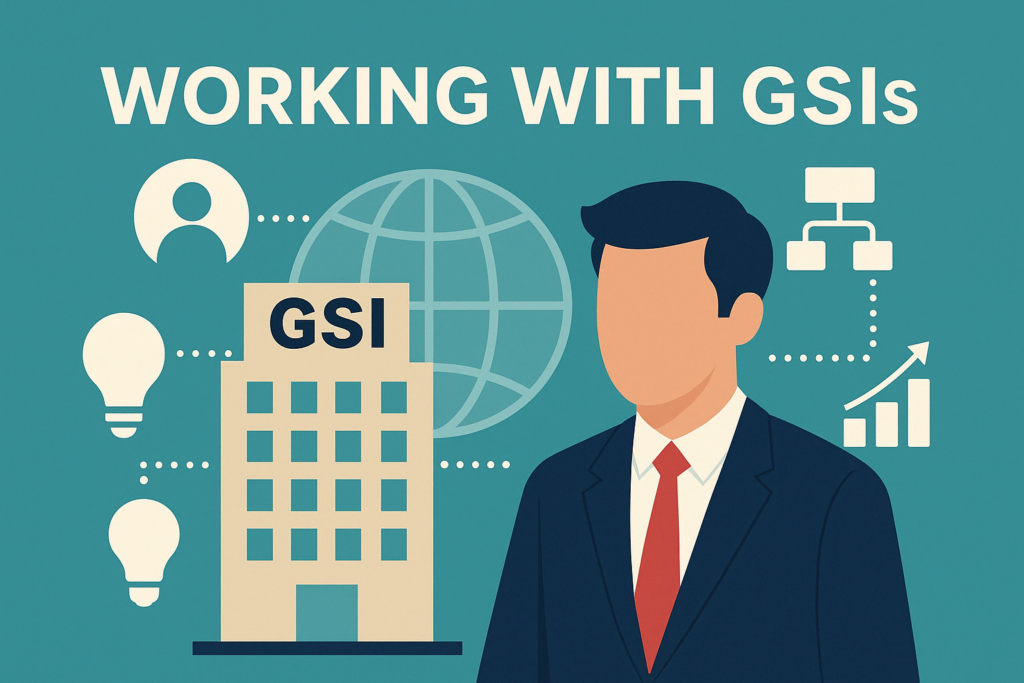
Global Systems Integrators (GSIs) are powerful partners—but navigating their complex structures can feel overwhelming. How do you effectively engage, align, and build lasting relationships with them? Let’s break it down.
Inside a GSI: How Are They Structured?
To successfully engage a GSI, start by understanding their internal structure. Here are the typical teams technology partners interact with:
Alliances and Partnerships Team:
Your primary contact point for managing the partnership lifecycle.Practice Leaders:
They integrate partner solutions into service offerings and ensure alignment with customer needs.Centers of Excellence (CoE) Leads:
Responsible for creating joint solutions, developing best practices, and reusable assets.Sales and Account Managers:
Customer-facing folks with a great understanding of what the customer wants, how to position services/solutions, and most importantly, how the customer thinks.Delivery Managers:
Oversee the successful implementation and execution of joint projects.
Decision Making Within GSIs: What Drives Engagement?
Engagement decisions aren’t made by one person or team—they’re collective. The decision-makers typically include industry leaders, solution architects, alliance managers, sales, and delivery teams. They evaluate partners based on several critical factors:
Solution Fit: Does your solution clearly address the customer’s pain points?
Innovation Potential: Can your offering support future transformation initiatives (like AI, hybrid cloud, cybersecurity)?
Time-to-Market: Will partnering accelerate customer profitability or enhance customer experiences?
Cost Efficiency: Can your technology help customers achieve stronger returns on investment?
Understanding these drivers positions your partnership for long-term success.
Earning Trust: The Partnership Essentials
Building trust with a GSI doesn’t happen overnight. Focus on these core areas to establish credibility and trust:
Educate and Enable:
Invest time in training, webinars, and creating internal product champions within the GSI. Leverage your Alliance Manager—they’ll help you navigate the internal ecosystem.Align Sales Teams:
Ensure transparency and foster collaboration between your sales team and the GSI’s sales force. Working together accelerates sales cycles, benefits the customer, and reinforces mutual credibility.Executive Alignment:
Engage executives from both sides regularly. Executive sponsorship is crucial for strategic alignment and maintaining momentum.Invest Jointly:
Commit funds for joint go-to-market initiatives, market development activities, and shared demand generation.
Common Pitfalls: What Partners Should Avoid
Many tech partners stumble by:
Expecting Immediate Results:
GSIs focus on critical customer projects—partnership results take time.Rigid Approaches:
Every deal is unique. Flexibility in adapting your solution and business model is key.Bypassing the GSI:
Avoid directly influencing the customer independently of the GSI. It creates confusion and jeopardises relationships. Rely on your Alliance Manager for direction.
Being patient, adaptable, and collaborative helps prevent these common mistakes.
Preparing to Partner: Setting Yourself Up for Success
When approaching a GSI:
Have Realistic Timelines:
Understand onboarding processes and set expectations for long-term relationship growth.Invest Early:
Share product knowledge consistently across teams. The seeds you plant today become tomorrow’s successful partnerships.Allocate Resources:
Set aside budget and resources to support joint market initiatives.Work Closely with Your Alliance Manager:
They’re your guide, advocate, and facilitator within the GSI ecosystem.
The RISE Framework: A Strategic Approach to GSI Engagement
To simplify your approach, leverage the RISE framework to guide your strategy:
Relationship:
Prioritise building and nurturing genuine, trust-based relationships.Influence:
Engage stakeholders strategically. Understand their diverse needs and be prepared to support them effectively.Scale:
Leverage executive relationships, share market intelligence, and pursue joint opportunities to expand your reach together.Execution:
Consistently deliver on your joint go-to-market plans. Regular check-ins keep both teams aligned and accountable.
Make it Strategic, Keep it Authentic
Cracking the GSI code isn’t just about your technology—it’s about your mindset.
Be strategic, patient, collaborative, and flexible. GSIs thrive on trust, alignment, and mutual success. Adopt the RISE framework, engage authentically, and watch your partnership soar.